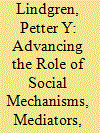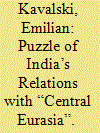| Srl | Item |
| 1 |
ID:
169252


|
|
|
|
|
| Summary/Abstract |
In this article, I further develop the Copenhagen School’s securitization theory in a causal direction, by emphasizing the explanatory family of mechanisms, mediators and moderators. In the first half of this article, I present two models for conceptualizing the causal maps that securitization is part of. Next, I define five epistemological and methodological dimensions that are important for modelling securitization with causal power. The proposed approach is then put into practice by two most-similar case studies in the second half of the article: securitization attempts in Japan in 2006-07 and in 2012-15. By comparing his securitization efforts in 2006 and in 2012-15 respectively, I identify why PM Abe was successful in his securitization attempt in the latter period. Furthermore, I propose an explanatory set that together with securitization enabled certain effects to take place in Japan, namely the introduction of collective self-defense in 2014/15.
|
|
|
|
|
|
|
|
|
|
|
|
|
|
|
|
| 2 |
ID:
169246


|
|
|
|
|
| Summary/Abstract |
This article argues that current passive and static conceptualizations of Chinese approaches to nuclear and conventional deterrence are no longer appropriate. Recent evidence indicates that these postures are far more integrated, flexible, and dynamic than Beijing’s official rhetoric suggests, and that during the past decade a de facto shift toward a limited nuclear war-fighting posture has already taken place. By applying an International Relations (IR) structural-realist lens to conceptualize a relatively under-researched discourse that relates to recent indications that China is contemplating the deployment of nuclear weapons for war-fighting (or victory-denial) purposes. A radical doctrinal shift of this kind (or even the perception of one) could presage a paradigm shift in China’s long-standing nuclear posture and the nuclear balance in Asia.
|
|
|
|
|
|
|
|
|
|
|
|
|
|
|
|
| 3 |
ID:
169248


|
|
|
|
|
| Summary/Abstract |
Sino-Indian interactions after the mid-19th century had a causal influence on Chinese and Indian elite perceptions. Modern China encountered modern India as an agent of British imperialism. China perceived India as an “imperial” power in the late 1940s by resorting to the availability heuristic while doubting India’s intentions in Tibet/Southeast Asia. By contrast, India viewed China as a fellow victim of colonialism that had sought India’s help during World War II. Consequently, India perceived China as a “partner” in postwar/postcolonial Asia. This interpretation was based on confirmation bias after 1947, despite contradictory Chinese signals. India’s image of China changed only after the 1950–51 invasion/annexation of Tibet. India then ascribed the image of an “expansionist/hegemonic” power to China based on historical analogy. Nevertheless, they carefully calibrated their strategies towards each other in consonance with these images until the 1959 Lhasa Uprising, thereby preventing their relationship from descending into militarized hostilities.
|
|
|
|
|
|
|
|
|
|
|
|
|
|
|
|
| 4 |
ID:
169251


|
|
|
|
|
| Summary/Abstract |
This article asks whether campus preaching organizations such as the Indonesian Muslim Students Islamic Union (KAMMI) and Hizb ut-Tahrir Indonesia (HTI) serve as potential breeding grounds for radicalism or, alternatively, do they serve as institutions that promote political moderation and prevent radical action among young university-age Muslims. Utilizing insights from inclusion-moderation thesis, it concludes the answer to these questions depends on whether these groups are willing to accept Indonesia’s democratic political system. These determine the tactics the groups chose to promote their agenda to potential recruits. While KAMMI is willing to moderate its strategies, HTI is unwilling to do so and continues to promote its agenda through secretive means, although it formally rejects radicalism and extremism.
|
|
|
|
|
|
|
|
|
|
|
|
|
|
|
|
| 5 |
ID:
169247


|
|
|
|
|
| Summary/Abstract |
The deterioration of Russia-US relations as a consequence of the Ukraine crisis and growing tensions in US-China relations have given rise to the perception that China–-Russia relations are an actual or incipient alliance. However, the alliance elements in China-Russia relations have never been systematically defined and empirically assessed, which makes assessing alliance dynamics in these important bilateral relations difficult. This article develops and applies a set of empirical criteria for an alliance to define how closely the post-Cold War China-Russia military relations have approached the alliance condition. It demonstrates that China and Russia have created strong institutional foundations for an alliance, and now only minor steps are necessary for a formal and functioning military alliance to materialize. However, the occurrence of such steps is not yet guaranteed.
|
|
|
|
|
|
|
|
|
|
|
|
|
|
|
|
| 6 |
ID:
169249


|
|
|
|
|
| Summary/Abstract |
The reconstruction of stable political order after violent conflict is a central concern of peacebuilding theory and practice. While much of the literature on this subject is based on cases where there has been state collapse or international intervention, this article draws on a case study from India’s northeast, where a long-standing separatist insurgency has given way to a stable and protracted ceasefire. Drawing on fieldwork from Ukhrul district in the India–Myanmar border, the article studies the parallel military structures and civilian governance institutions and the nature of their interaction. In doing so, it evaluates the consequences of the ceasefire political equilibrium in terms of the larger project of conflict resolution and a permanent political resolution.
|
|
|
|
|
|
|
|
|
|
|
|
|
|
|
|
| 7 |
ID:
169250


|
|
|
|
|
| Summary/Abstract |
India’s relations with Afghanistan and the post-Soviet countries of Central Asia have contributed to the growing interest in the country’s rise. By treating them together as “Central Eurasia,” the discourses of Indian foreign policy invoke a contiguous geopolitical locale bound to India by a shared past. Yet, despite the strategic articulation of a manifest Central Eurasian region, the article uncovers a puzzle of bifurcation in India’s foreign policy reflecting distinct operationalizations of India’s cultural capital in its relations with Afghanistan and the Central Asia republics. The comparative analysis indicates that prior historical experience becomes a compelling strategic context for the continuous framing and reframing of the country’s foreign policy space, which reveals India’s shifting perceptions of international order, self-identity, and global roles. India’s interactions in Central Eurasia offer a good illustration of the crossroads that New Delhi’s foreign policy is facing – either keep on proliferating discourses that spin yarns of the international influence of its historical capital or develop proactive diplomatic strategies that deliver the international status that India desires.
|
|
|
|
|
|
|
|
|
|
|
|
|
|
|
|